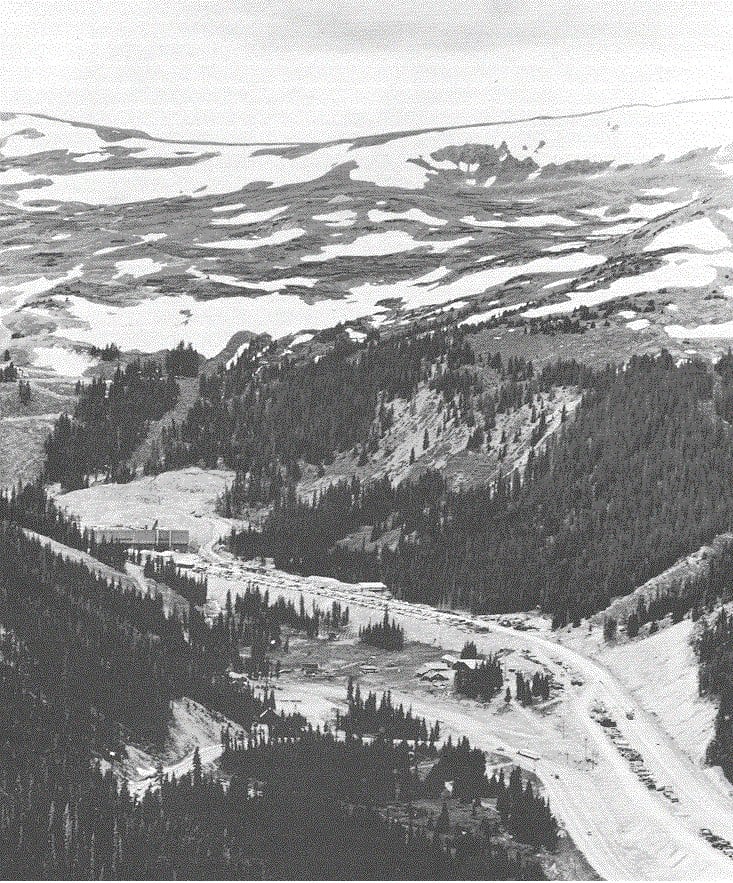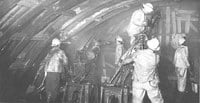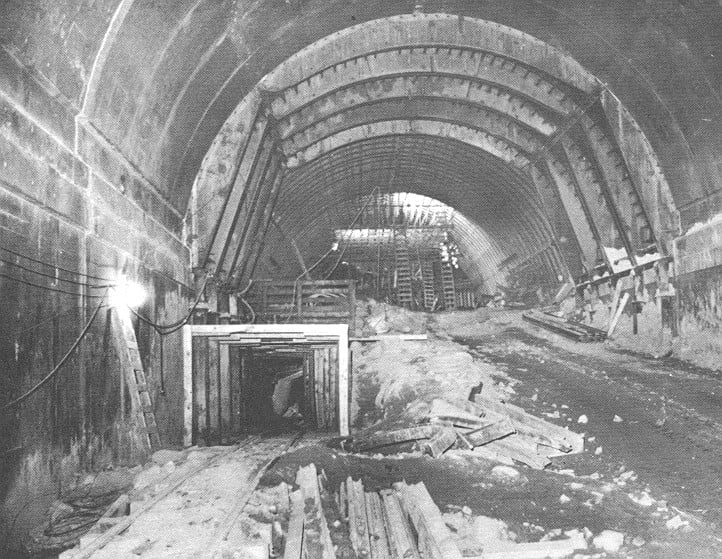Eisenhower Memorial Bore

Eisenhower Tunnel- Connecting Colorado for 50 Years
The Eisenhower Memorial Tunnel opened to two-way traffic on March 8, 1973 and celebrates a big milestone of "Connecting Colorado for 50 Years" on March 8, 2023. Millions of drivers travel through the tunnel every year, but this wouldn't be possible without the many people involved in the tunnel's rich and interesting history.
The Eisenhower Memorial Tunnel went under construction March 15, 1968. A four-company joint venture, Straight Creek Constructors, held a contract with the the Colorado Division of Highways to drive two lanes of an eventual twin bore tunnel under the Continental Divide, 60 miles west of Denver.
Portal/ventilation buildings for the twin tunnels would be included, and stubs of the second bore would be driven. The goal was the first bore would be ready for use and employed for two-way Interstate 70 traffic in three years. The second would be completed several years later.
Three years, so went the theory...
But there were obstacles. Men and machines labored at lowered efficiency at eleven thousand feet. Winter kept the working season painfully short outside the tunnel. And the mountain wasn't 100 percent cooperative, or even 10 percent at times. Unprecedented stress showed up where theory dictated otherwise. New methods were needed, and were developed, to mine and support a hole some fifty feet high and forty-five feet wide. It was another of those cases where fact and theory had to be reconciled.
Doubters scoffed, and believers toiled...
Finally, the job was ready for traffic, but only after five years of soul searching, back breaking and budget busting. As one veteran highway engineer put it, "We were going by the book, but the damned mountain couldn't read."
The Eisenhower Tunnel was first called the Straight Creek Tunnel, a name derived from the valley where the west portal is located. The Colorado State Legislature chose the new title in 1972, officially designating it the Eisenhower Memorial Bore. Dedication of the Eisenhower Memorial Bore came on March 8, 1973, and the tunnel was opened to two-way traffic on that day.
Construction History

Following completion of a pioneer bore under Loveland Pass, in May 1943, the Department of Highways advertised for bids on a vehicular tunnel at the site, and received only one offer of $10 million on Sept. 16, 1947, which was not formally considered as it was a sole bid and far in excess of the engineers' estimate.
Upon re-advertising, the Department received no bids on opening day, Dec. 17, 1947. In 1956, bids were opened April 16 on two tunnel projects—one for Straight Creek and the other at Berthoud Pass. Only one valid bid was received on each, and no contract award was made.
Emphasis on a tunnel stemmed from a Bureau of Public Roads designation in October 1957, of a stretch of I-70 between Denver and Cove Fort, Utah. Federal money was not made available for construction on the Denver-Cove Fort leg until the 1962-63 budget.
In a report submitted to the Department in March 1960, an engineering firm—E. Lionel Pavlo, New York City—picked Straight Creek as the best of eight possible interstate routes between Empire Junction and Dotsero. It pointed out the need for a tunnel because of the impossibility of getting over the Divide while maintaining interstate standards.
In several contracts in 1962 and 1963, the Department of Highways provided for approach roads to the site of a pioneer bore that would be driven on the Straight Creek route, then contracted for the pioneer tunnel in October 1963. Mid-Valley, Inc., Houston, holed the tunnel through Dec. 3, 1964.
The call for bids for what we now know as the Eisenhower Tunnel opened on Oct. 3, 1967. This bid request represented the fourth one for a highway tunnel under the Continental Divide.
The project included:
- Construction of the westbound bore
- Starting the eastbound bore a short distance into the mountain at each end
- Construction of combination portal and ventilation buildings for both bores at the east and west entrances
- Installation of necessary facilities for use in the westbound tunnel, such as lighting, other utilities and the electronic surveillance system.
The prime contractor for the mine and seven-tenths of the project was Straight Creek Constructors. Venture members were Al Johnson Construction Company (Minneapolis), Gibbons and Reed Company (Salt Lake City), Kemper Construction Company (Los Angeles) and Western Paving Construction Company (Denver).
At the height of activity, as many as 1,140 persons were employed in three shifts, 24 hours a day, six days a week.
Finance
Federal aid on this interstate project was 91.32 percent, and was administered through the Federal Highway Administration. The rest was state funded. The contracting venture started the project on a basis of pay-by-bid items which, when totaled, amounted to the low bid. However, effective Dec. 16, 1970, pay procedures on mining items were changed to a cost basis because of difficulties encountered in mid-mountain.
From the start of preliminary engineering to closeout of the project, about $108 million was expended and, at the time, set a record for a federal aid single project. Compared to a Division of Highways' estimate of $42,479,000, the low bid of $54,140,486 was accepted on Oct. 3, 1967 from Straight Creek Constructors.
Location
The east entrance is in Clear Creek County and the west entrance is in Summit County. The east entrance is approximately 60 miles west of Denver, and roughly 10 miles west of Silver Plume. The facility lies entirely within Arapaho National Forest land, and no privately owned right of way is involved. The west portal is in the valley of Straight Creek, while the east portal is in Loveland Basin and the valley of South Clear Creek.
Length and Grade
From outside, face to outside face of the ventilation buildings, the distance is 8,941 feet—or 1.693 miles. Of this distance, there are 7,789 feet of rock tunneling, and a total of 1,152 feet of ventilation/portal structures and cut-and-cover sections at the east and west ends.
The westbound tunnel climbs from east to west at an average grade of 1.64 percent (rising 1.64 feet for each 100 feet on the horizontal). There are slight vertical curves in the eastern half, and a vertical curve inside each portal serves as a transition from the tunnel grade to the grade of the approach roads.
Rock Formations

Geologic studies show that bedrock in the tunnel areas consist of 75 percent granite, and 25 percent gneiss and schist. There are local dikes of augite diorite. There are faults and shear zones as well as solid bedrock.
In the pilot bore, 26.5 percent of its length was in self-supporting rock; 73.5 percent required supports in varying degrees, and the total footage of what tunnelers call "bad" rock was 820 feet. Because the location of the westbound bore lies between 115 and 230 feet to the north, rock conditions there did not exactly duplicate those of the pilot tunnel.
Extrapolation from stresses measured in the pioneer bore to those expected in the vehicular tunnel did not prove to be absolutely exact in every case.
Design
Approximate Quantities of Some Major Items
| Excavation (in tunnel) | 524,000 cubic yards |
| Portal excavation | 90,000 cubic yards |
| Other excavation | 477,000 cubic yards |
| Concrete, tunnel lining | 190,000 cubic yards |
| Concrete, buildings | 34,000 cubic yards |
| Steel reinforcing bars in tunnel | 10,000 tons |
| Structural steel, tunnel | 23,400 tons |
| Structural steel, buildings | 2,600 tons |
| Reinforcing steel, buildings | 2,100 tons |
For Straight Creek Constructors, the joint venture that held the contract, these men were in charge at the site at the opening date, March 8, 1973.
| Project Administrator | Glen Nielson |
| Project Manager | W.K. McGlothlin |
| Project Engineer | Werner Ruemmele |
| General Superintendent | R.A. Gillette |
For the Division of Highways, key personnel at the construction site at opening date included:
| District Engineer | R.C. Hopper |
| Tunnel Construction Engineer | P.R. McOllough |
| Tunnel Superintendent | John B. Cook |
